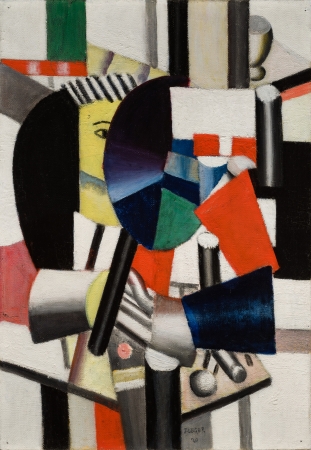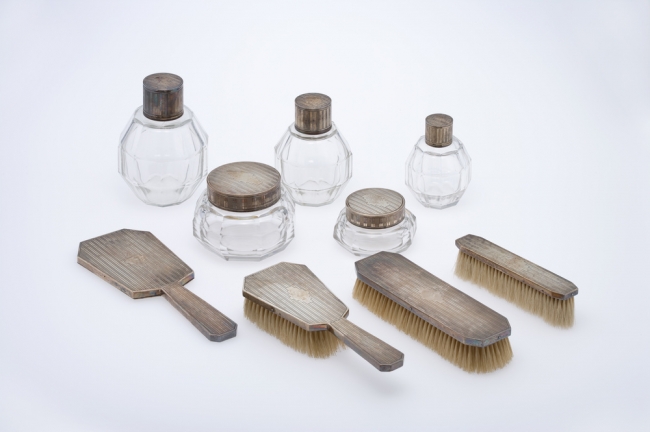The Pola Museum of Art unveiled a new acquisition, Fernand Léger's (1881-1955) Woman with a Mirror, for the first time as part of the themed exhibition "LEGER & ART DECO: 100 Years Ago in the Future," which began on June 1st. Léger is a French artist who, along with Picasso and Braque, is considered one of the greatest Cubists of the 20th century. About 100 years ago, Léger studied painting while working as an architectural draftsman in Paris. Based on his "machine aesthetics," which sees aesthetic beauty in machines, he depicted the rapidly industrializing landscapes of his time in a new style that took into account technical aspects such as drafting and industrial production techniques.

Woman with a Mirror is a painting of intricately assembled geometric shapes such as spheres, cylinders, and cuboids, painted in white, black, red, blue, yellow, and green. The world depicted by Léger is filled with the excitement of progress opened up by technological innovation and the brilliance of machine worship. This is the first time that a Léger oil painting has been added to our museum's collection. Our museum's Léger collection now includes two pieces, including prints. The themed exhibition "LÉGER&ART DÉCO 100 Years Ago in the Future" will feature newly acquired works, as well as Léger's short film "Ballet Mécanique" and prints. In addition, in connection with Léger's theme of "women looking at mirrors," the exhibition will also feature hand mirrors and cosmetic tools in the Art Deco decorative style that swept Europe at the time, as well as masterpieces of glass perfume bottles by René Lalique, an artisan who was active during this period.
![René Lalique]()
![Perfume Bottle]()

■Highlights of the "LÉGER & ART DÉCO 100 Years Ago in the Future" Exhibition
Approximately 100 years ago, two major trends emerged, mainly in Paris, appropriate to the arrival of the Machine Age, in which machines were seen as a symbol of a new era. These were "Modernism," led by artist Fernand Léger and architect Le Corbusier, which aimed for pure forms, and the decorative style of "Art Deco," which featured geometric designs.
Forms inspired by the industrial products created by Léger's contemporaries, as well as the expression of new-age materials such as metal and glass, are permeated with a futuristic originality and strength. Enjoy the beauty of "the future 100 years ago," created with a rich imagination of the near-future world.
(This exhibition will be held in the permanent exhibition room until November 3rd (Tuesday, national holiday) during the "Monet and Matisse" exhibition.)
■Work Description
Fernand Léger, Woman with a Mirror, 1920, Oil on canvas, 55.6 x 38.7 cm
In this work, the flat face of a woman with long hair and voluminous features such as cylindrical arms and fingers are arranged around an oval shape representing a mirror, as if unrelated to gravity. The grid-like composition and arrangement of vibrantly colored surfaces suggest that Léger was conscious of the grid-like compositions used by Cubism and De Stijl, the Dutch abstract art group that included Mondrian.
After returning from the battlefield after World War I, Léger produced a series of eight female figures holding mirrors in 1920. Five of these are titled "Women with Mirrors," like this work, and the other three are known as "Women Applying Makeup." The pose of female figures peering into a mirror and flirting with beauty has been depicted with various meanings as a traditional subject in Western painting. Since the 1910s, Léger had focused on heroic figures, such as workers on construction sites and in factories, but it was with this series, begun in 1920, that he began to explore the theme of female figures.
■Fernand Léger 1881-1955
Born in Argentan, a town in Normandy. He worked as an architectural draftsman in Paris and studied painting at the École des Arts Décoratifs and art academy. Inspired by the Cubist and Futurist paintings of Cézanne, Picasso, and Braque, he pursued simple forms and clear colors. In 1911, he became a member of the Cubist group "Section d'Or" (Golden Section), and aimed to create avant-garde works with themes of urban landscapes and workers. In addition to paintings and illustrations, he also worked on architectural murals, stained glass, ceramics, sculpture, and film.
■About the Pola Museum of Art's Collection
The museum's collection was amassed over 40 years by Suzuki Tsuneji, the second generation of the Pola founding family, and includes a wide variety of items, including Western and Japanese paintings, glass art, and cosmetic tools, totaling 10,000 pieces. Of these, the Western paintings that form the core of the collection are a group of works that trace the development of modern painting, centered on France, from the late 19th century through to the 20th century.
■About the Pola Museum of Art
Opened in 2002 in Hakone, Kanagawa Prefecture. Taking advantage of its location in Fuji-Hakone-Izu National Park, the walking trails allow you to enjoy the rich nature of the four seasons.
・Opening Hours: 9:00-17:00 (last entry at 16:30)
・Closed: Open everyday (may be closed temporarily for exhibit changes)
・Address: 1285 Kozukayama, Sengokuhara, Hakone-machi, Ashigarashimo-gun, Kanagawa Prefecture
・Tel: 0460-84-2111
Click here for company press release details

Woman with a Mirror is a painting of intricately assembled geometric shapes such as spheres, cylinders, and cuboids, painted in white, black, red, blue, yellow, and green. The world depicted by Léger is filled with the excitement of progress opened up by technological innovation and the brilliance of machine worship. This is the first time that a Léger oil painting has been added to our museum's collection. Our museum's Léger collection now includes two pieces, including prints. The themed exhibition "LÉGER&ART DÉCO 100 Years Ago in the Future" will feature newly acquired works, as well as Léger's short film "Ballet Mécanique" and prints. In addition, in connection with Léger's theme of "women looking at mirrors," the exhibition will also feature hand mirrors and cosmetic tools in the Art Deco decorative style that swept Europe at the time, as well as masterpieces of glass perfume bottles by René Lalique, an artisan who was active during this period.

■Highlights of the "LÉGER & ART DÉCO 100 Years Ago in the Future" Exhibition
Approximately 100 years ago, two major trends emerged, mainly in Paris, appropriate to the arrival of the Machine Age, in which machines were seen as a symbol of a new era. These were "Modernism," led by artist Fernand Léger and architect Le Corbusier, which aimed for pure forms, and the decorative style of "Art Deco," which featured geometric designs.
Forms inspired by the industrial products created by Léger's contemporaries, as well as the expression of new-age materials such as metal and glass, are permeated with a futuristic originality and strength. Enjoy the beauty of "the future 100 years ago," created with a rich imagination of the near-future world.
(This exhibition will be held in the permanent exhibition room until November 3rd (Tuesday, national holiday) during the "Monet and Matisse" exhibition.)
■Work Description
Fernand Léger, Woman with a Mirror, 1920, Oil on canvas, 55.6 x 38.7 cm
In this work, the flat face of a woman with long hair and voluminous features such as cylindrical arms and fingers are arranged around an oval shape representing a mirror, as if unrelated to gravity. The grid-like composition and arrangement of vibrantly colored surfaces suggest that Léger was conscious of the grid-like compositions used by Cubism and De Stijl, the Dutch abstract art group that included Mondrian.
After returning from the battlefield after World War I, Léger produced a series of eight female figures holding mirrors in 1920. Five of these are titled "Women with Mirrors," like this work, and the other three are known as "Women Applying Makeup." The pose of female figures peering into a mirror and flirting with beauty has been depicted with various meanings as a traditional subject in Western painting. Since the 1910s, Léger had focused on heroic figures, such as workers on construction sites and in factories, but it was with this series, begun in 1920, that he began to explore the theme of female figures.
■Fernand Léger 1881-1955
Born in Argentan, a town in Normandy. He worked as an architectural draftsman in Paris and studied painting at the École des Arts Décoratifs and art academy. Inspired by the Cubist and Futurist paintings of Cézanne, Picasso, and Braque, he pursued simple forms and clear colors. In 1911, he became a member of the Cubist group "Section d'Or" (Golden Section), and aimed to create avant-garde works with themes of urban landscapes and workers. In addition to paintings and illustrations, he also worked on architectural murals, stained glass, ceramics, sculpture, and film.
■About the Pola Museum of Art's Collection
The museum's collection was amassed over 40 years by Suzuki Tsuneji, the second generation of the Pola founding family, and includes a wide variety of items, including Western and Japanese paintings, glass art, and cosmetic tools, totaling 10,000 pieces. Of these, the Western paintings that form the core of the collection are a group of works that trace the development of modern painting, centered on France, from the late 19th century through to the 20th century.
■About the Pola Museum of Art
Opened in 2002 in Hakone, Kanagawa Prefecture. Taking advantage of its location in Fuji-Hakone-Izu National Park, the walking trails allow you to enjoy the rich nature of the four seasons.
・Opening Hours: 9:00-17:00 (last entry at 16:30)
・Closed: Open everyday (may be closed temporarily for exhibit changes)
・Address: 1285 Kozukayama, Sengokuhara, Hakone-machi, Ashigarashimo-gun, Kanagawa Prefecture
・Tel: 0460-84-2111
Click here for company press release details
The press releases featured in this article have been provided by PR TIMES, Inc. and are reproduced verbatim. FASHION HEADLINE does not recommend the products or services featured, nor does it guarantee the contents of the press releases. For inquiries regarding the content of the publications, please contact PR TIMES Inc. directly (https://prtimes.jp/).


![Our Fashion Story [vol.28_ DIOR × Contemporary]](https://wrqc9vvfhu8e.global.ssl.fastly.net/api/image/crop/533x712/images/upload/2025/11/1d7732ea5c65c54c096829dba8830b9e.jpg)













